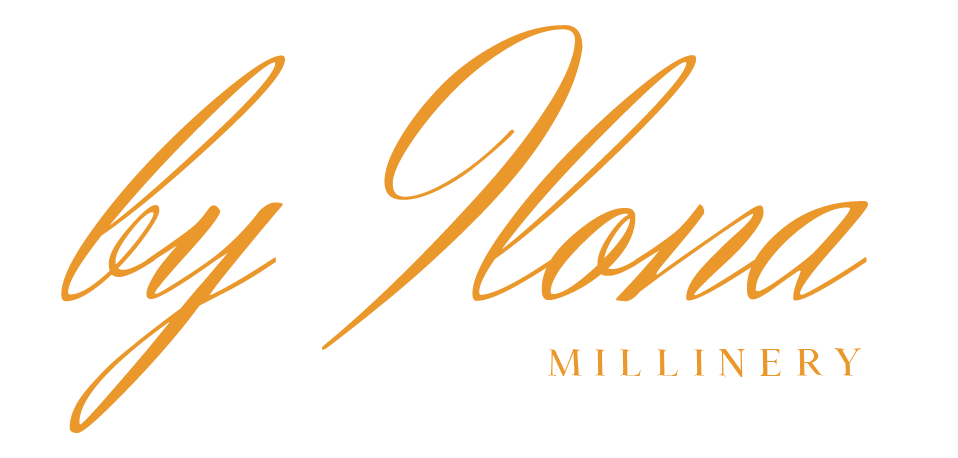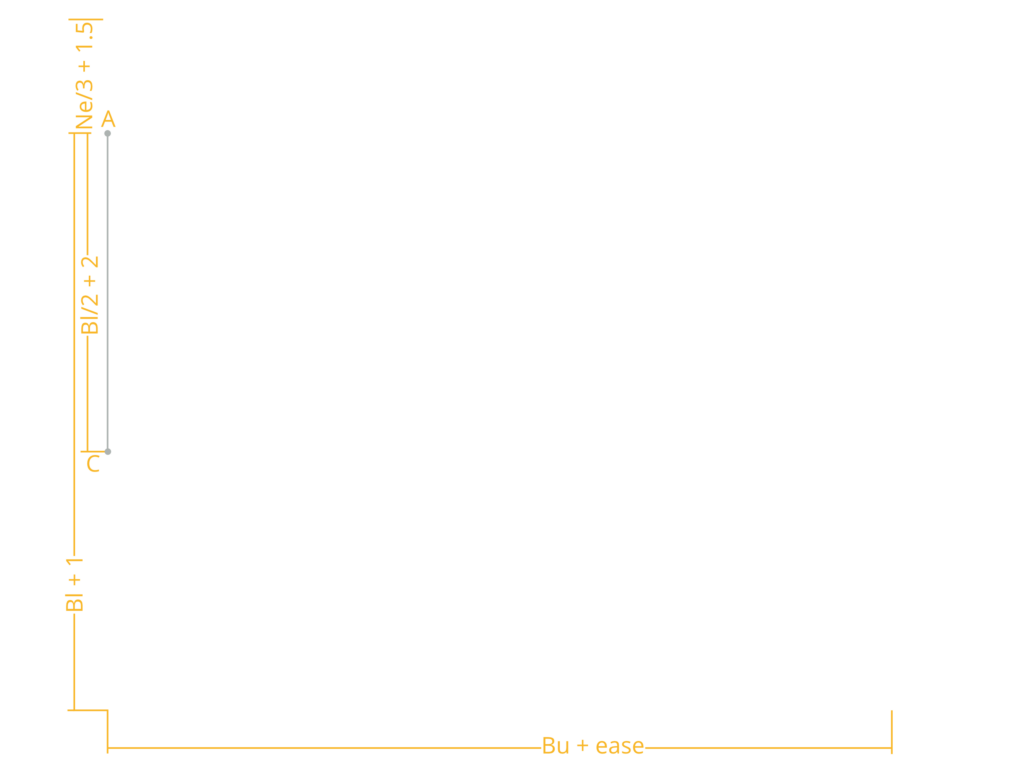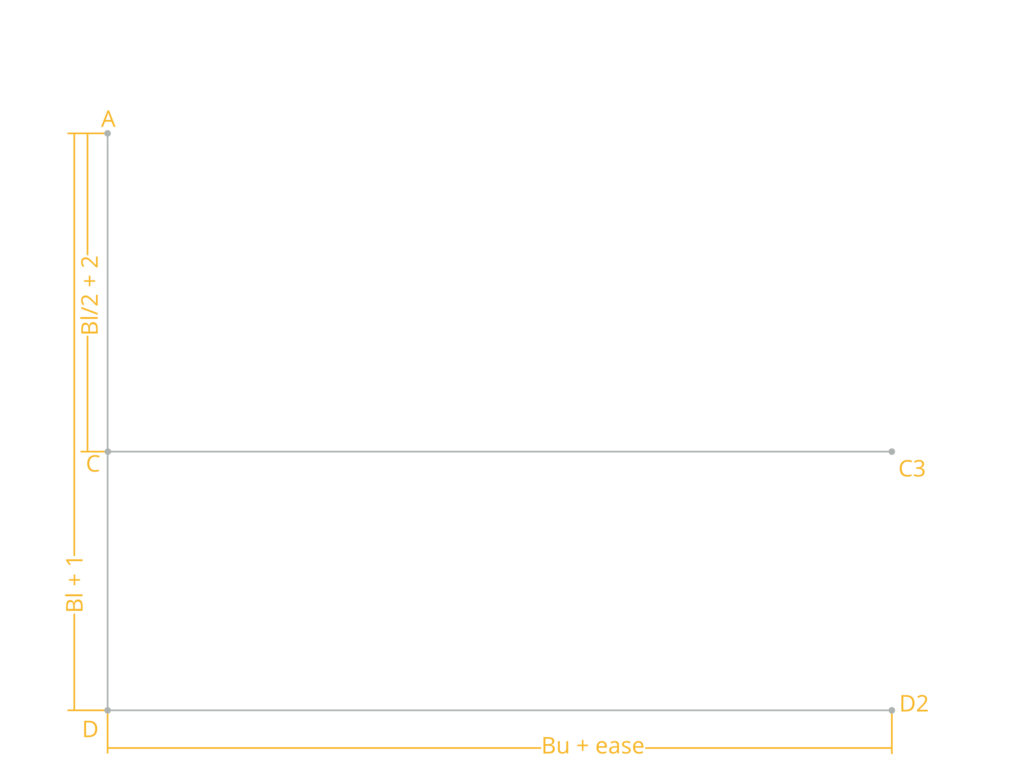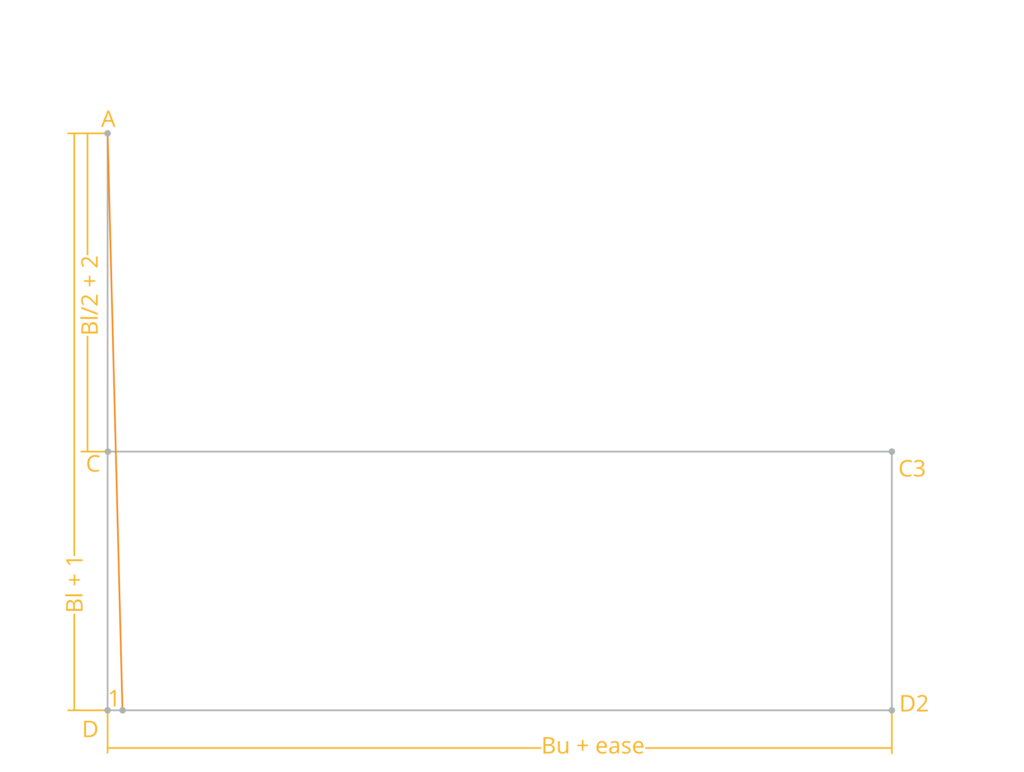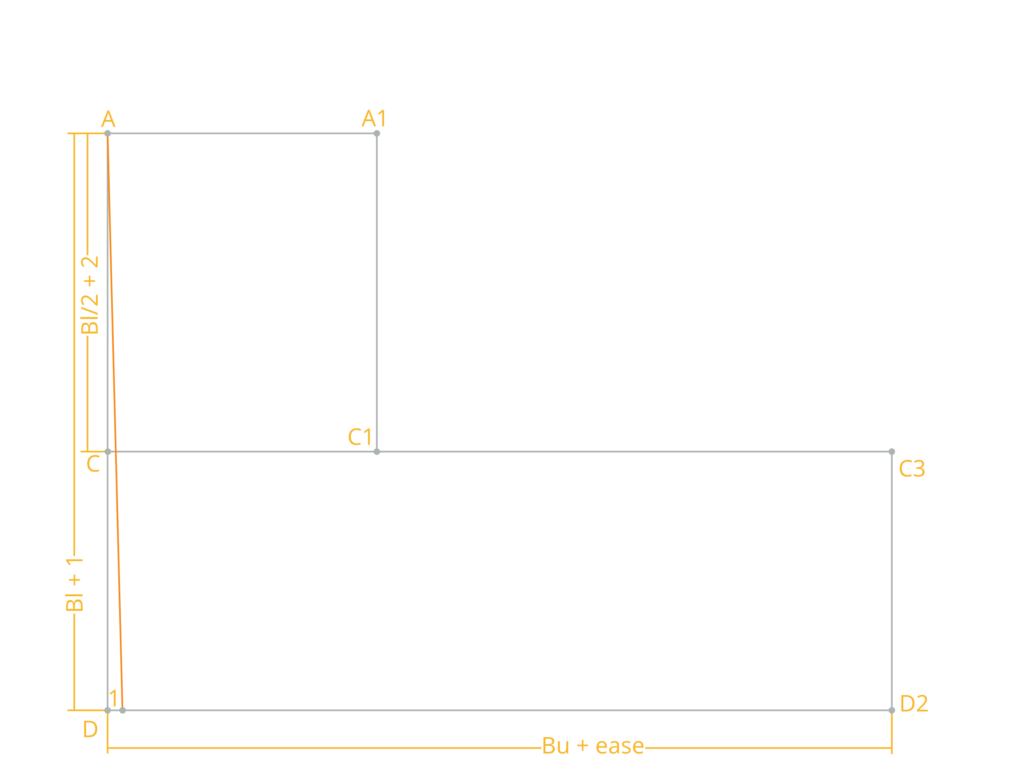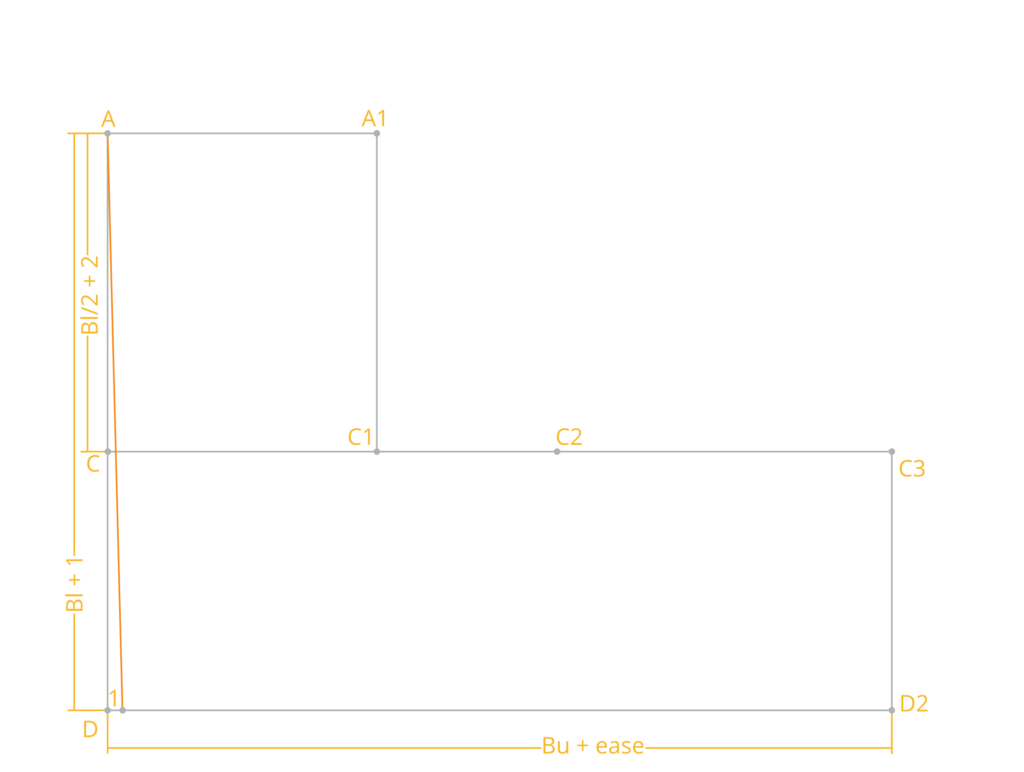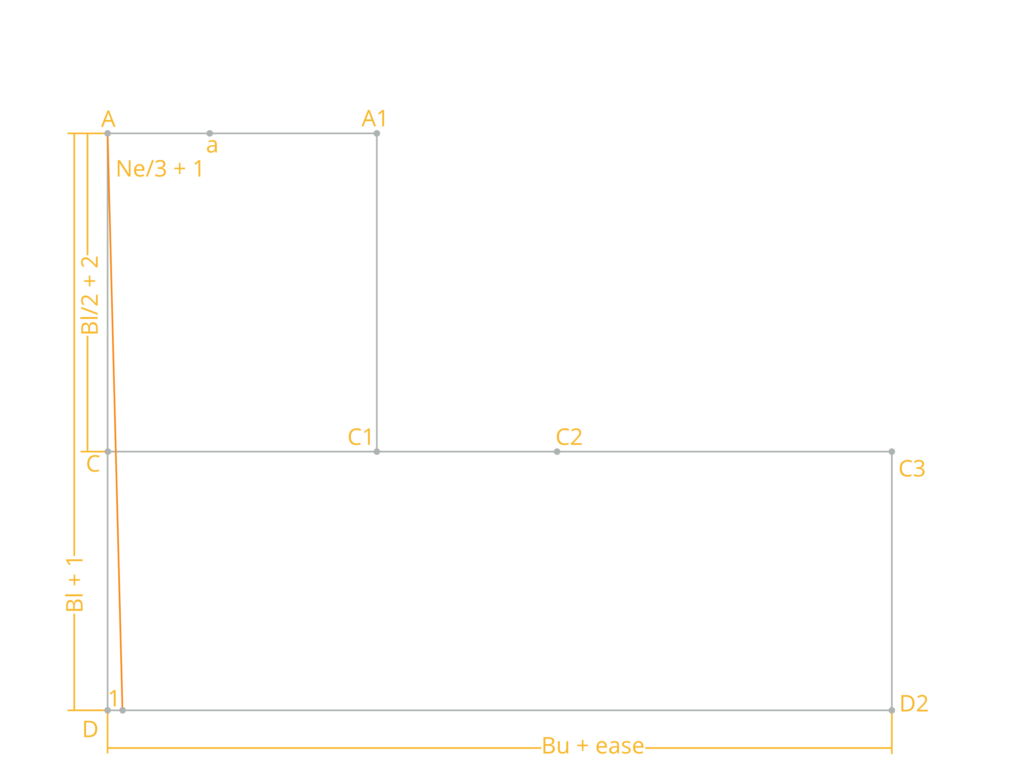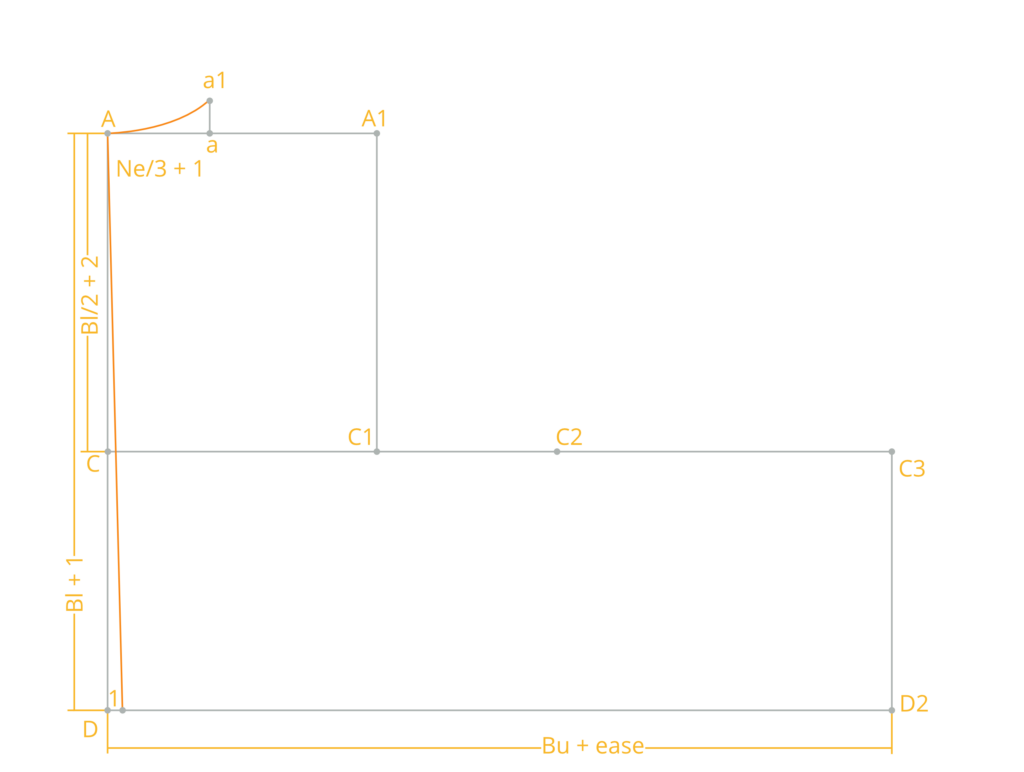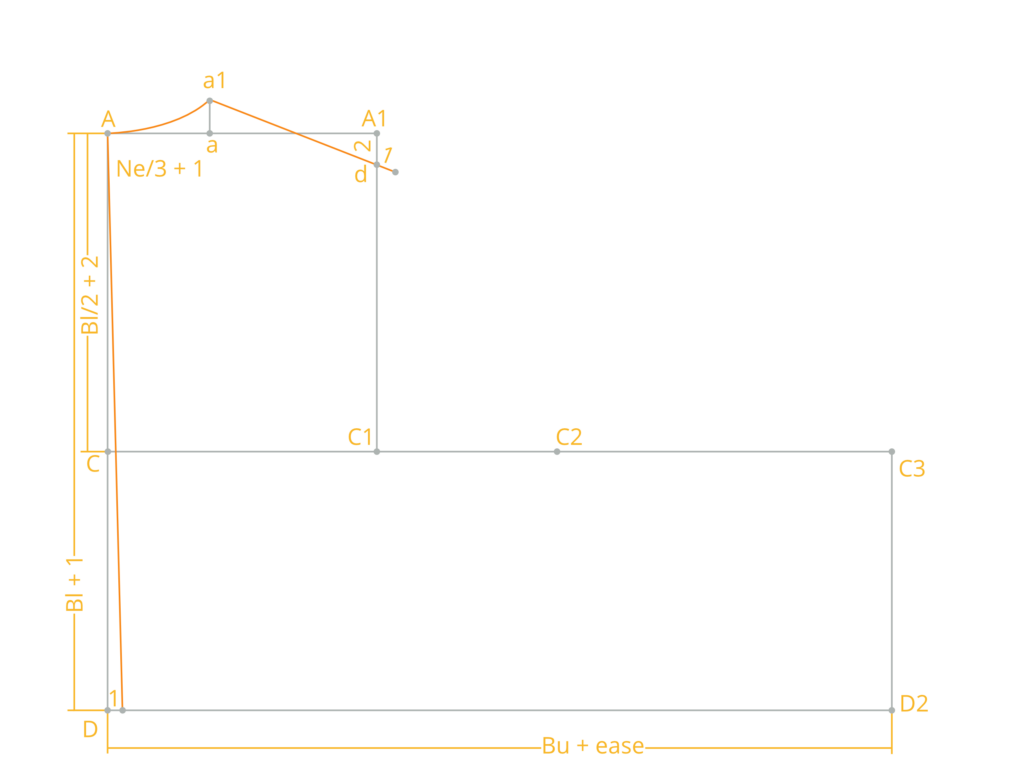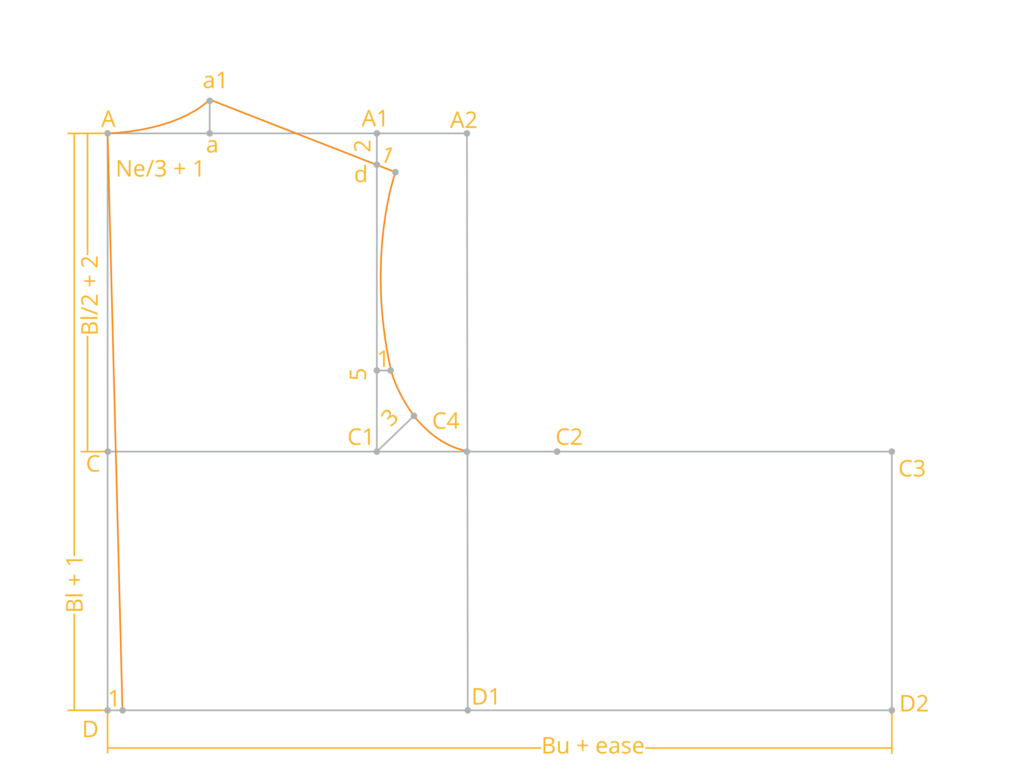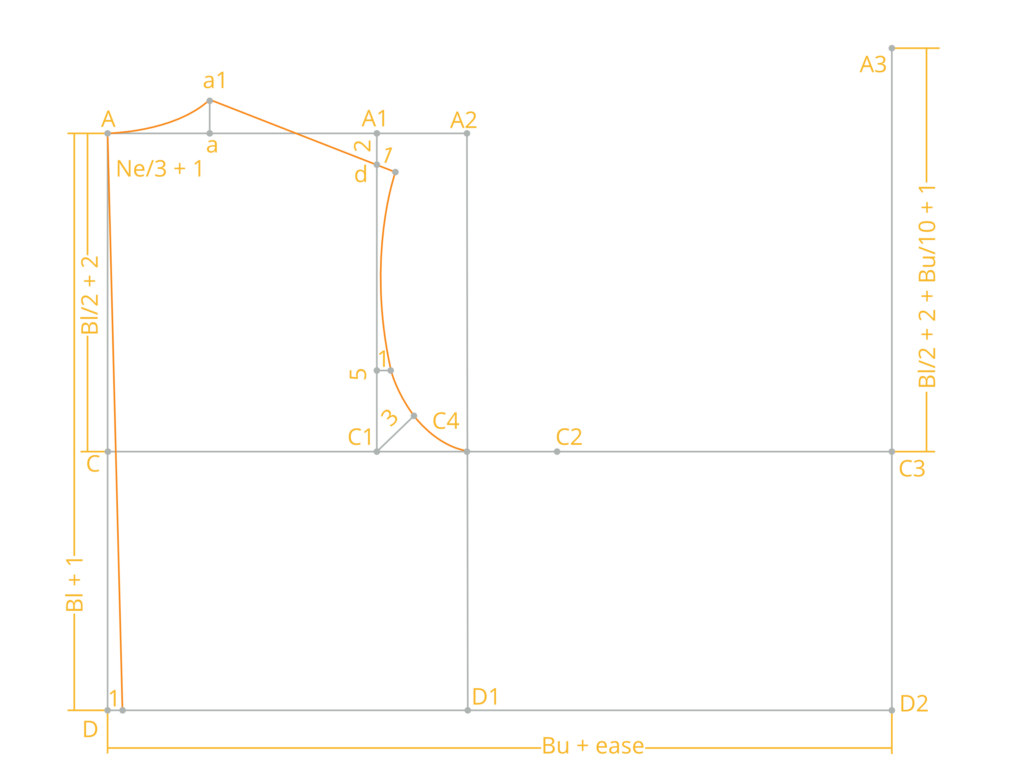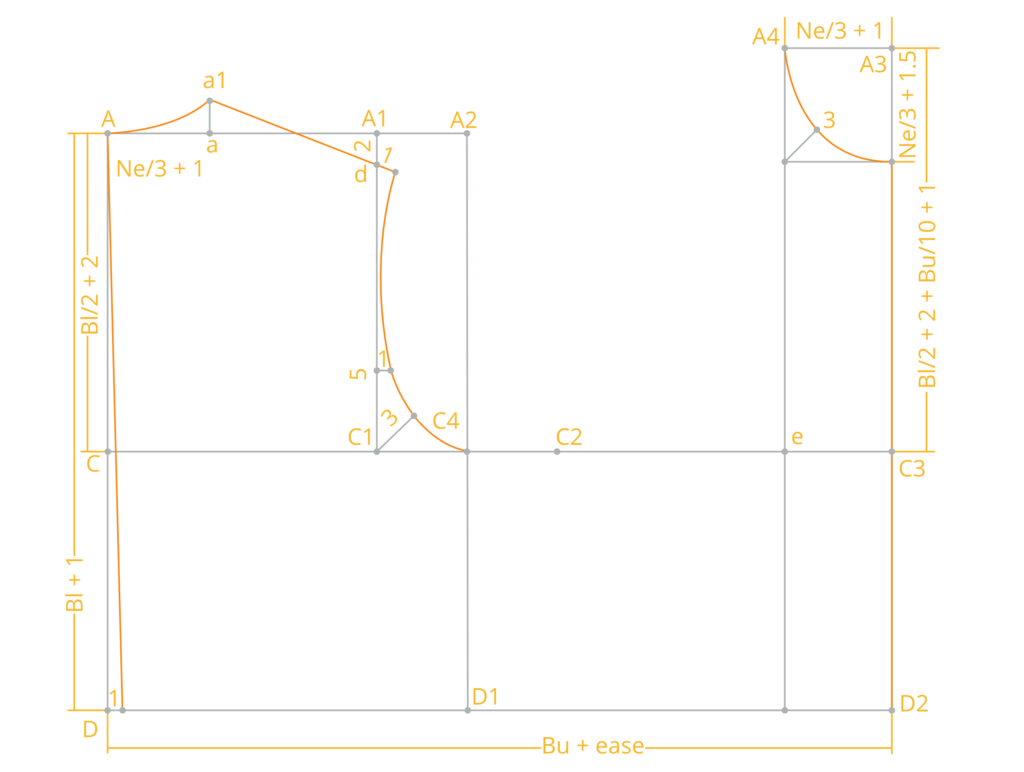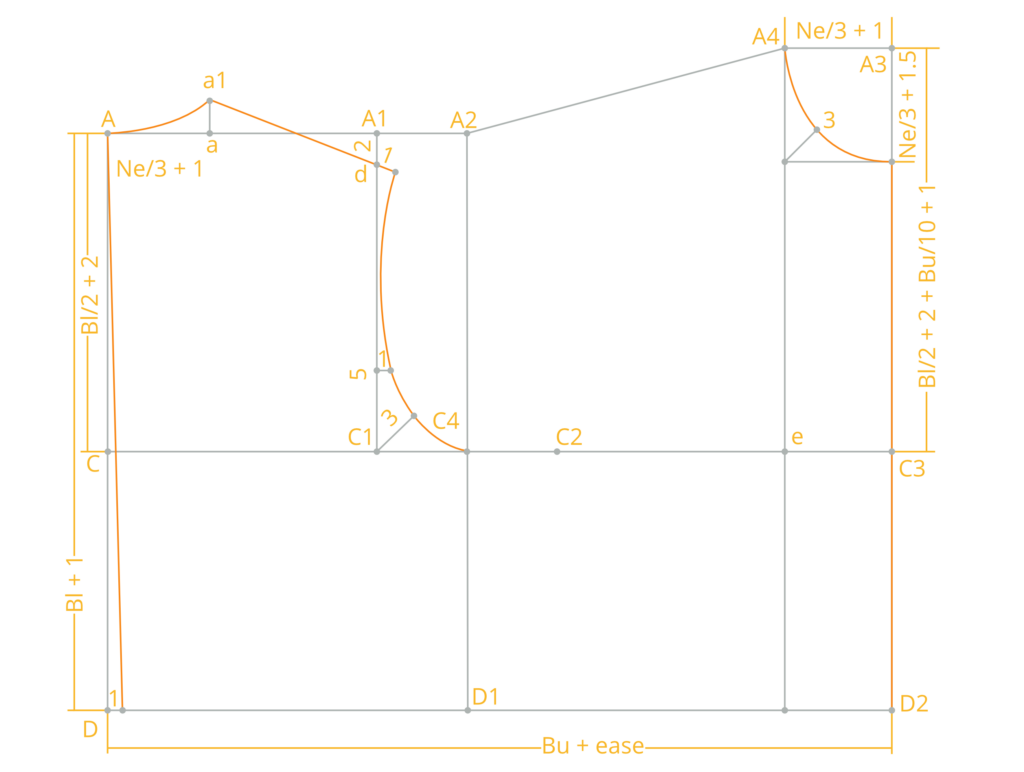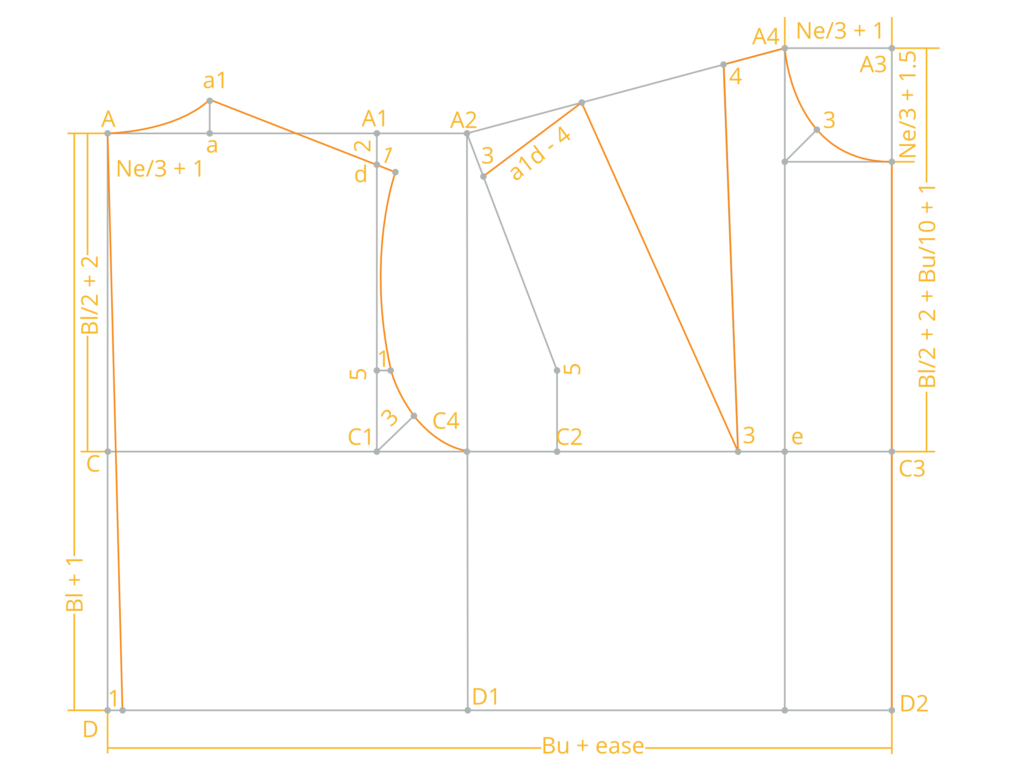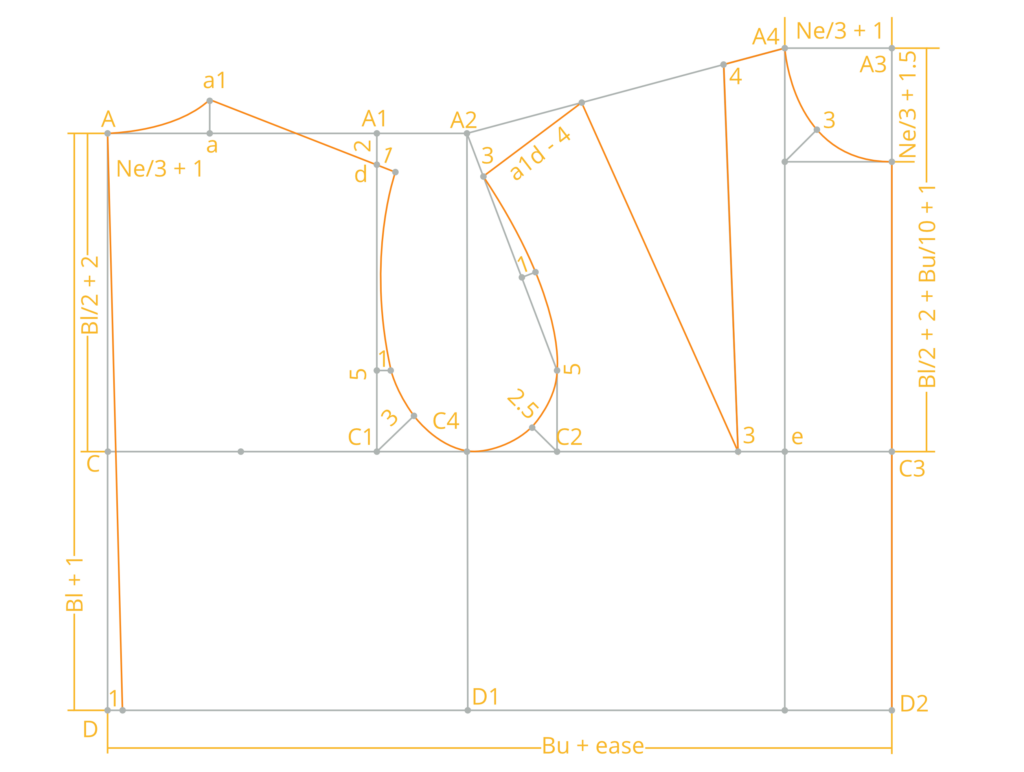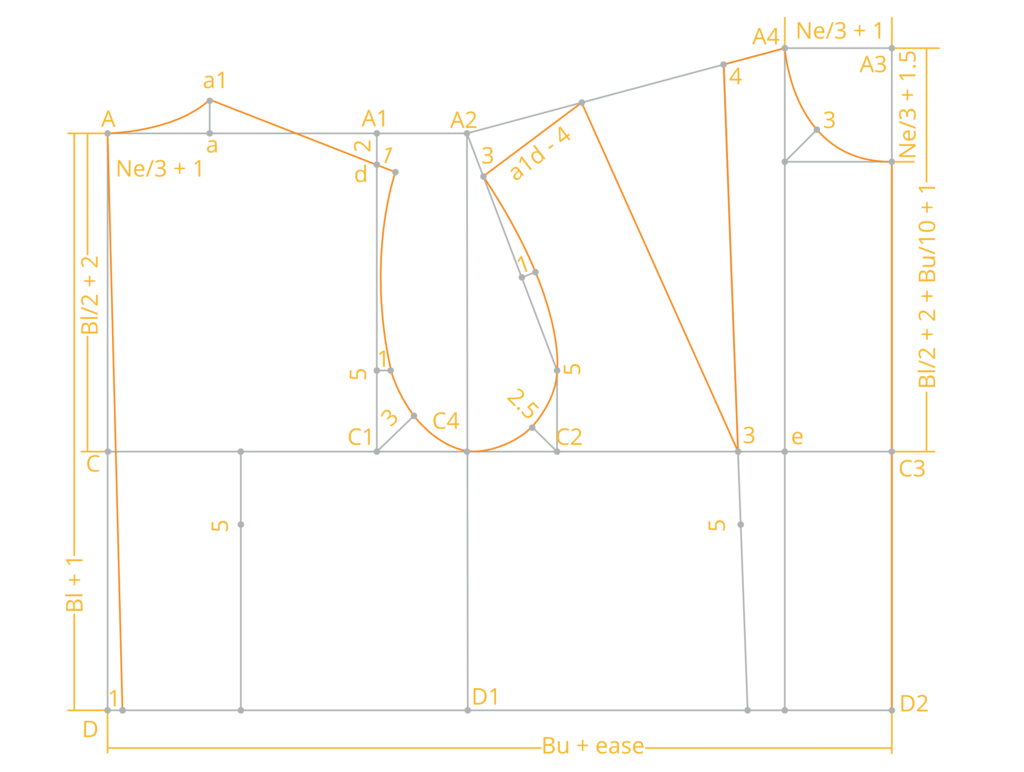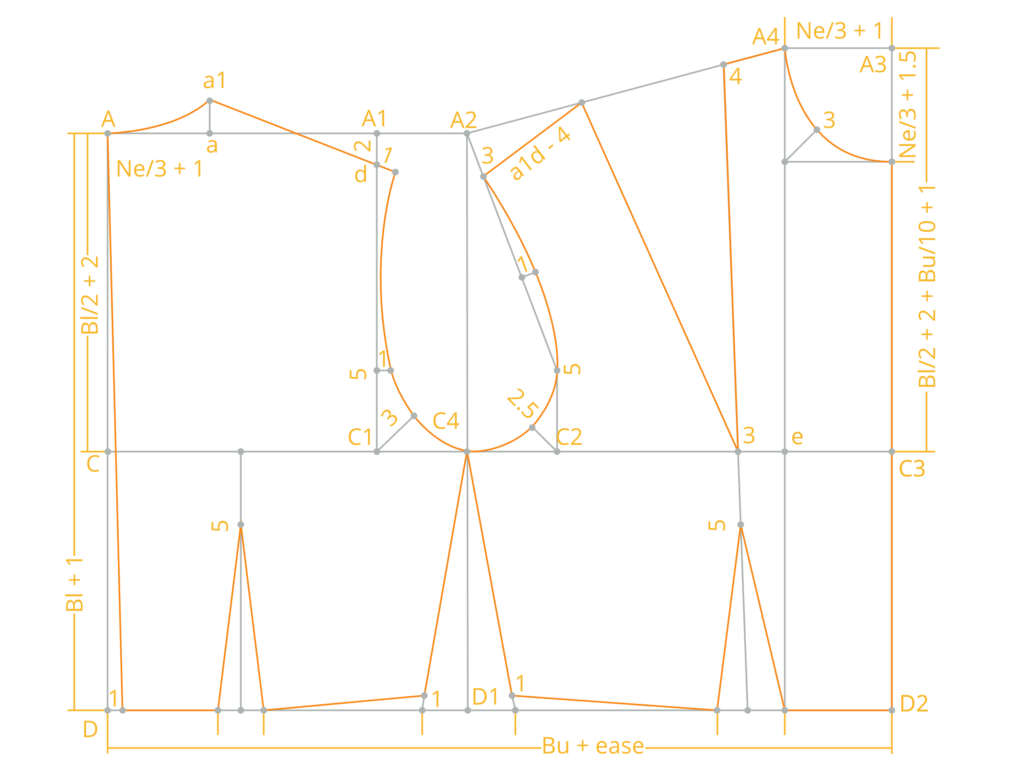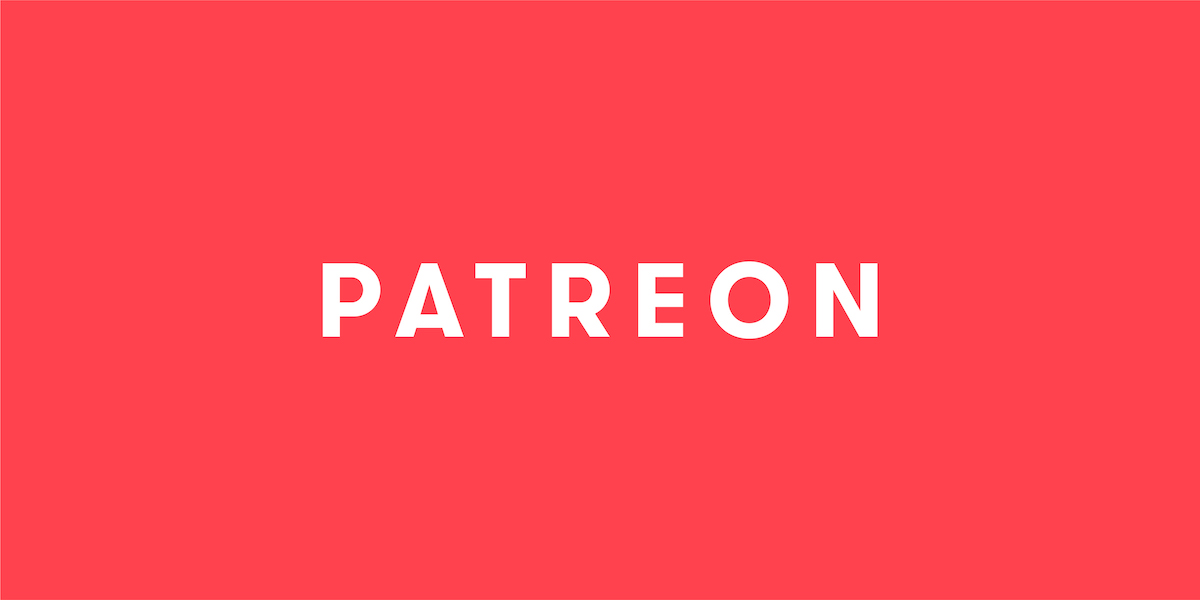All measurements are in Centimetres.
HOW TO FOLLOW THESE INSTRUCTIONS
- Read the whole set of instructions from beginning to end.
- Start by noting down your measurements.
- Download the spreadsheet with the formulas. Follow the link to a google sheets copy, you can then add it to your own google drive, or download it and edit it on your computer. You can also write out the formulas on paper and calculate them manually. Double check all your measurements and calculations.
- You may find it easier to open this same web page in 2 browser windows side by side, so that you can see the instructions alongside the diagrams.
TOOLS:
Paper for drafting, note paper, pencil, fine pen, rubber, tape measure, long ruler, French curve ruler, protractor.
MEASUREMENTS
Copy out the table below into a notebook, or copy and paste it into a word processor. Remember to also note down the date as it can be useful to refer back to when your measurements were last taken.
Using a flexible measuring tape, follow the instructions in the table to take your measurements. It is easier if you have someone to help. When taking measurements, stand as you would normally; don’t straighten up and suck your stomach in as this could result in an ill fitting garment. Take the measurements loosely – it should be possible to fit an extra finger in between your body and the measuring tape.
All measurements should be done in Centimetres. Keep your measurements to 1 decimal place. For the “Final” column, all horizontals are halved, and all verticals are recorded as they are taken.
Description |
Abbreviation |
Measurement |
Final |
| Neck Take around the base of the neck. |
(Ne) | ||
| Bust Take around the fullest part of the bust. |
(Bu) | ||
| Waist Bend to the side – this is where your waist is. Make sure you take this measurement loosely, as you can decide later if you want it smaller for a tighter fit. |
(Wa) |
|
|
| Hips Measure around the widest part of where your hips are. This measurement is usually 2-4cm larger than the bust (Bu). |
(Hi) |
|
|
| Back Width Take along the back from underarm to underarm. |
(Bw) | ||
| Shoulder Length Take from neck point to shoulder point. |
(Shl) | ||
| Sleeve Length Keeping your arm down, measure from the shoulder point to your thumb knuckle. |
(Sl) |
|
|
| Wrist Measure around your wrist, then add 2cm. |
(Wr) |
|
|
| Back-Waist Length Take down the centre back from prominent neck bone to waist line. |
(Bl) | ||
| Front-Waist Length Take from side neck point straight down over bust to waist line. |
(Fl) | ||
| Ease |
Ease |
You will also need to decide on how much ease you will incorporate. A few mid-century books suggest an ease of 3cm to 5cm for a loose fitting. I prefer taking measurements loosely enough to only need a 1cm ease.
THE FORMULA SPREADSHEET
The formula spreadsheet on google drive. Follow this link and add the file to your google drive. Alternatively you can download the sheet and edit it on your computer.
DIAGRAM
In this diagram, the Yellow lines are guideline measurements, grey lines are helpful placeholders, orange lines are the finished pattern.
Check that you have enough area on your paper using this formula.
Width = Bu + ease
Length = (Bl + 1) + (Ne/3 +1.5)
DRAFTING THE BACK
ARMHOLE LENGTH
Starting at the top left of your paper, draw a vertical line downwards. The length of this line is half the back length divided by 2, plus 2. Label the ends of this line A and C, as shown in the diagram.
AC = Bl/2 + 2
BACK LENGTH
From point A, draw a vertical line downwards. The length of this line is back length plus 1. Label this point D.
AD = Bl +1
From points C and D, draw horizontal lines equal to bust width plus ease. Label the end points C3 and D2.
CC3 = DD2 = Bu + ease
VERTICAL MIDDLE OF BACK
On the waist line, from point D, plot a point 1cm across to the right, and join this up with point A. This will be the centre back line.
BACK WIDTH
Along line CC3, plot point C1 to the right of point C, at a distance of the back width plus 1, (or instead of adding 1, just round up).
CC1 = Bw + 1 (or instead of adding 1, just round up)
From point C1, draw a vertical line upwards, ending parallel to point A. Label the top of this line A1, and join left to point A.
ARMHOLE WIDTH
From point C1, measure along the same line to the right, a distance of 1 tenth of the bust width multiplied by 2, plus 2, and label this point C2.
C1C2 = Bu/10 * 2 + 2
NECKLINE WIDTH
From point A, measure along the same line to the right, a distance of 1 third of neck plus 1, and label this point a.
Aa = Ne/3 + 1
NECKLINE DEPTH
From point (a) draw vertical line upwards. The length of this line is 1 third of the neckline width (the previous formula of distance Aa). Label this point a1. Join up points A and a1 with a curve. This is the back neckline.
aa1 = (Ne/3 + 1) /3
BACK SHOULDER
From point A1, plot a point 2cm down the line A1C1, mark this point d.
Join point a1 to d, then extend this line by 1cm to the right.
This length should be equal to the shoulder length (shl) plus 1.The back shoulder length has to be 1cm longer than the front shoulder length to accommodate the shoulder blade point. This extra cm can either be eased into the front shoulder seam, or converted into a dart.
BACK ARMHOLE
Plot a point half way between C1 and C2, label this point C4. Through C4 draw a vertical line. The top of this line should be parallel to point A1. The bottom of this line should stop at the waistline. Label the bottom point D1, and the top point A2.
On the line C1A1, mark a point 5cm up from C1. From this point, draw another point 1cm horizontally to the right.
From point C1, mark another point at a 45 degree angle 3cm away.
Join up points C4, 3, 1 and 1 using a french curve.
DRAFTING THE FRONT
FRONT WIDTH
Extend line D2C3 upwards by half the back length plus 2, plus 1 tenth of the bust, plus 1. Label the end of the line as A3. This will be the centre front line.
C3A3 = (Bl/2) + 2 + (Bu/10) + 1
NECKLINE
From point A3 draw a horizontal line to the left. The length of this line is 1 third of the neck, plus 1. Label this point A4.
A3A4 = Ne/3 + 1
Measure down along the line A3C3 a distance of 1 third of the neck, plus 1.5. This point marks the centre front neck point.
Ne/3 + 1.5
Draw a horizontal line to the left out of this point, and square up to point A4. From that corner plot another point at a 45 degree angle 3cm away.
Draw a vertical line down from point A4, where this line crosses line CC3, mark a point e.
FRONT SHOULDER SLANT
Join points A2 and A4.
BUST DART
Along the line A4A2, mark a point 4cm to the left from point A4.
Along the line C3C4, mark a point 3cm across to the left from point e.
Join up these new points. This is the right bust dart leg.
From point C2 draw a vertical 5cm line upwards. Join this point to point A2. Along this line from point A2, measure 3cm and mark a point.
Calculate a1d – 4, which should the shoulder length minus 4.
Use this length to join point 3 up to line A4A2. Join that point to the bust dart point. This is the left bust dart leg.
FRONT ARMHOLE
Mark a point half way between the 3cm point and the 5cm point. From there, draw a perpendicular 1cm line to the right.
From point C2, draw a 2.5cm line at a 45 degree angle.
Join up points C4, 2.5, 5, 1 and 3 with a french curve.
WAIST DARTS
Mark a point halfway between point C and C1. Draw a vertical line downwards to meet with the waist line. This is the centre line of the back dart. Measure 5cm down this line from line CC1, this is the dart point.
For the front waist dart, extend the right bust dart leg down to meet the waist line. Measure 5cm down along this line from line C4C3, this is the dart point.
CALCULATING THE WAIST DARTS
Front: bust plus ease, takeaway 1cm, minus the waist. All divided by 3.
((Bu + ease – 1) – (Waist)) / 3
Back: bust plus ease, minus the waist. All divided by 4.
((Bu + ease) – (Waist)) / 4
Sides: bust plus ease, minus the waist, minus the front and back darts.
(Bu + ease) – waist – (front dart + back dart)
For each dart, half the values calculated in the above formulas, mark points either sides of the dart centre lines, and join up to the dart points.
To finish the waistline, measure 1cm up each side dart leg, and join these points to the front and back waist dart legs.
NEXT STEPS
Now add seam allowances, and make a toile to check the fit. There may still be adjustments that need to be made. Remember to label and write down all the alterations that are made.
